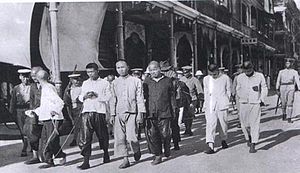| Shanghai massacre | |||||||
|---|---|---|---|---|---|---|---|
 Communists being rounded up during the purges | |||||||
| |||||||
| Belligerents | |||||||
|
Green Gang |
| ||||||
| Commanders and leaders | |||||||
|
(NRA commander-in-chief) (NRA commander in Shanghai) Du Yuesheng (Green Gang leader) |
(CCP general secretary) | ||||||
| Units involved | |||||||
|
|
| ||||||
| Strength | |||||||
| Approx. 5,000 soldiers of the 2nd Division of the 26th Army and members of various gangs | Thousands from labor union militias | ||||||
| Casualties and losses | |||||||
| Minimal | 5,000[1]–10,000[2] killed | ||||||
| Shanghai massacre | |||
|---|---|---|---|
| Traditional Chinese | 四一二事件 | ||
| |||
| Alternative name | |||
| Traditional Chinese | 四一二清黨 | ||
| Simplified Chinese | 四一二清党 | ||
| |||
| Alternative name(2) | |||
| Traditional Chinese | 東南清黨 | ||
| Simplified Chinese | 东南清党 | ||
| |||
| Alternative name(3) | |||
| Traditional Chinese | 四一二反革命政變 | ||
| Simplified Chinese | 四一二反革命政变 | ||
| |||
| Alternative name(4) | |||
| Traditional Chinese | 四一二慘案 | ||
| Simplified Chinese | 四一二惨案 | ||
| |||
| Part of a series on the |
| Chinese Communist Revolution |
|---|
 |
| Outline of the Chinese Civil War |
|
|
The Shanghai massacre of 12 April 1927, the April 12 Purge or the April 12 Incident as it is commonly known in China, was the violent suppression of Chinese Communist Party (CCP) organizations and leftist elements in Shanghai by forces supporting General Chiang Kai-shek and conservative factions in the Kuomintang (Chinese Nationalist Party or KMT). Following the incident, conservative KMT elements carried out a full-scale purge of communists in all areas under their control, and violent suppression occurred in Guangzhou and Changsha.[3] The purge led to an open split between left-wing and right-wing factions in the KMT, with Chiang Kai-shek establishing himself as the leader of the right-wing faction based in Nanjing, in opposition to the original left-wing KMT government based in Wuhan, which was led by Wang Jingwei. By 15 July 1927, the Wuhan regime had expelled the Communists in its ranks, effectively ending the First United Front, a working alliance of both the KMT and CCP under the tutelage of Comintern agents. For the rest of 1927, the CCP would fight to regain power, beginning the Autumn Harvest Uprising. With the failure and the crushing of the Guangzhou Uprising at Guangzhou however, the power of the Communists was largely diminished, unable to launch another major urban offensive.[4]
- ^ Cite error: The named reference
carterwas invoked but never defined (see the help page). - ^ Cite error: The named reference
Ryan-Purnell-Plozzawas invoked but never defined (see the help page). - ^ Wilbur 1983, p. 114.
- ^ Wilbur 1983, p. 170.